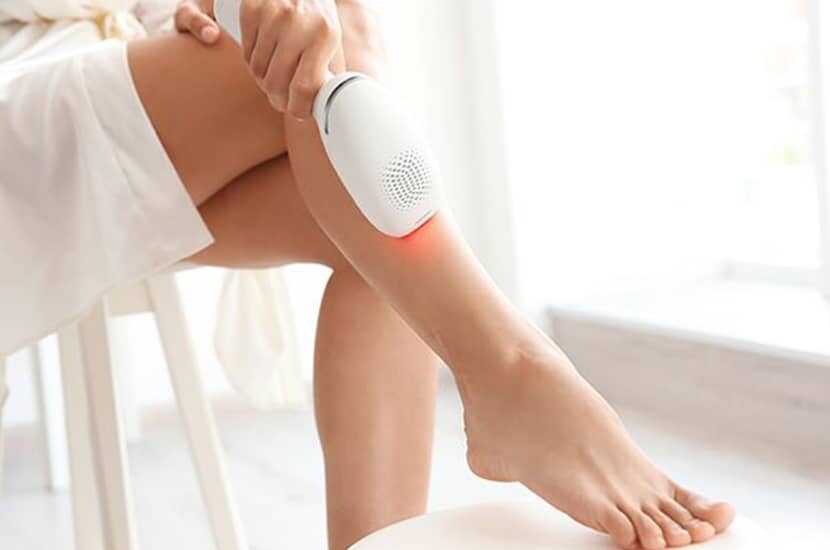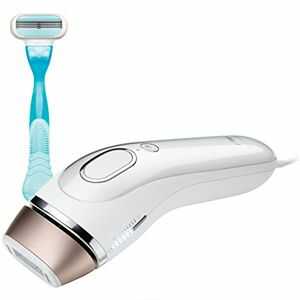
IPL and laser hair removal are both long-term procedures for reducing hair growth. They work in similar ways, and can both be very effective. In addition to preventing hairs from re-growing, both treatment methods can significantly reduce the growth speed of remaining hairs, as well as hair thickness.
Many patients and clients of both IPL and laser hair removal achieve very successful results, but to attain the best results, it is important to decide which method is more suitable for you.
Table Of Contents
- 1 IPL Vs. Laser Hair Removal, What Is The Difference?
- 1.1 How IPL Hair Removal Works
- 1.2 How Laser Hair Removal Works
- 2 IPL Or Laser, Which Is Better?
- 2.1 Benefits Of IPL Hair Removal
- 2.2 Benefits Of Laser Hair Removal
- 3 Using IPL and Laser For The Face
- 4 IPL And Laser Hair Removal Side Effects
- 5 How Long Have IPL And Laser Hair Removal Been Around?
- 6 IPL and Laser Hair Removal Results
- 7 At Home Laser and IPL Devices
- 8 Conclusion: Choosing the Light-Based Hair Removal For You
- 8.1 IPL
- 8.2 Laser
IPL Vs. Laser Hair Removal, What Is The Difference?

Laser and IPL hair removal both work on the same principle. That is that light energy is absorbed by areas of high pigment such as hairs, which are therefore heated up. The heat damages the follicle, slowing hair growth and even preventing it completely. The main difference between IPL and laser hair removal devices is the light source used. IPL uses broad-spectrum visible light whereas laser hair removal utilizes the properties of a laser.
How To Prepare For IPL Facial? Click here to learn more.
It is important to understand however how areas of skin which have higher pigment, such as freckles and moles, as well as darker skin generally, will also absorb more light energy and heat as a result. This may affect which hair removal method is best for you. To help you decide, here is some information on how both technologies work:
How IPL Hair Removal Works
IPL stands for Intense Pulsed Light and uses a source of broad-spectrum, visible light. This light is specially controlled to remove shorter wavelengths and devised to target specific structures. In hair removal, it is designed to target the melanin pigment in the hairs, while in other uses such as the treatment of spider vein it targets the hemoglobin in the blood. The light energy is absorbed, transferring as heat energy which warms the hair, causing damage to the follicle.
How Does IPL Laser Work? Click here to read in detail.
How Laser Hair Removal Works
Laser hair removallaser hair removal
IPL Or Laser, Which Is Better?

Choosing between IPL and laser treatment is a personal decision. Your skin tone and hair color can affect the results you can achieve with both laser and hair removal, so it is important you understand which is best for you, so you can achieve the outcomes you desire. You should consider your skin and body type and the amount you wish to spend and how quickly you want to see results.
How Long Should You Wait Between IPL Treatments? Click here to find out.
Benefits Of IPL Hair Removal
As broad-spectrum light naturally spreads out, the coverage of IPL hair removal devices is greater than laser hair removal devices. It, therefore, may mean that treatment times may be quicker because larger areas can be treated at once. As well as treatment times being quicker, they may also be considerably cheaper, but you may find that you need more sessions to achieve the same results.
IPL uses a broad spectrum of light, which means it can have different uses. It can be used to treat a variety of different skin conditions very successfully. It can also be altered specifically to match different skin and hair types within a treatment type. For example, a variation of IPL called VPL, which stands for Variable Pulsed Light, has been developed. VPL enables the user to modify the settings of the light pulses to best suit the skin and hair they are aiming to treat. This is because the developers recognize that not only do different skin tones have different requirements for light-based hair removal devices and also that thick, course bikini line hair will require different treatment to thinner arm hair.
We recommend the Braun 5001 for IPL permanent air removal:

Check Price On Amazon
Benefits Of Laser Hair Removal
The nature of lasers means that laser hair removal devices can focus light down into the pores of the skin, getting closer to the follicle to treat it and ultimately prevent regrowth. This can mean that laser hair removal can achieve much quicker results than IPL because single hairs are heated to damaging temperatures quicker. Therefore, you may need fewer treatments of laser hair removal to achieve the same results.
Being more specific also means that laser hair removal can be more suited to people who have darker skin. This is because darker skin also absorbs more light than paler skin due to the amount of melanin (pigment) it contains, like darker hairs absorb more light than paler hairs. Therefore, there is a risk that the darker skin can be heated up. The nature of lasers being more focused, smaller areas of light mean that they are more suited to treating people with darker skin because they greatly reduce the risk of burning compared to IPL. Having said that, some IPL systems are still suitable to be used on darker skin.

Check Price On Amazon
Using IPL and Laser For The Face
Both laser and IPL hair removal are techniques that are suitable for use on the female face. However, neither should be used on the scalp or eyebrows. They are safe to use below the cheek line for example on the upper lip or chin, but should not be used in proximity to the eyes as the glare of the light may damage your sight. For this reason, it is important to use sufficient eye protection whenever you are using IPL or laser hair removal, even if you are not treating your face. Some at-home kits come with eye protection included, but if they don’t you can get them cheaply. It is also important that you do not look directly into the light source.

IPL And Laser Hair Removal Side Effects
Both IPL and laser hair removal methods have the same side effects. You can expect some skin irritation which may be in the form of redness, swelling, itchiness or feeling tender. However, this is normally short lived and should not last more than a day. Simply treat the skin irritation like you would sunburn and keep it moisturized.
The skin will be more sensitive to sunlight after both methods, so it is important that you use adequate sun protection on the skin both before and after treatment. It is also important that you do not scratch the skin as it may be more delicate and that you keep the skin clean to prevent infection.
Click here to find out how to correct IPL damage.
How Long Have IPL And Laser Hair Removal Been Around?
The first use of IPL documented in academic literature took place in a study in 1997, where hair loss was found to be a side effect of skin treatment with IPL. This study used an IPL device called Photoderm VL and looked to treat facial port wine stains (birthmarks). Researchers found that the lesions responded well to the first treatment and completely cleared up after the fourth. Soon after this study, the authors published two cases of permanent removal of facial hair. The same author also published an article which successfully used IPL to treat essential telangiectasias (ETE), which is another skin condition. Since then, the technology has vastly improved and resulted in the creation of more powerful and predictable IPL devices.
Laser hair removal, on the other hand, was first developed significantly earlier, in 1960. Initial designs were sadly slow and resulted in burns, but the technology quickly progressed, with the first FDA-cleared laser for hair removal becoming available in 1964. Laser hair removal increased in popularity after that, and the FDA finally cleared an at-home laser hair removal kit, the Tria Laser 4X for permanent hair reduction in 2008.
IPL and Laser Hair Removal Results

Neither IPL or laser hair removal techniques will grant immediate results. Unlike with waxing and threading, you won’t leave the treatment session with completely smooth, hair-free skin. The hairs will instead drop out as they die over the next few weeks and those which have not been affected due to the stage of the growth cycle they were in for the first treatment will require another session (or more). You will be able to shave in between sessions though, as you don’t need to have any grow-out times.
However, the benefit of both IPL and laser hair removal over waxing and threading is that over time you will achieve permanent reduction of hair growth. Hairs that do grow will do so slower, so you won’t need to shave as often. They will also likely grow back thinner and less course. They may even grow paler, so they are less obvious.
Most people find they can achieve permanent hair loss from treated areas after between 1 and 10 treatments, with an average of 6 sessions for adequate results. Whichever method you choose, you may need to occasionally have a top-up treatment every few months or yearly, but you are likely to notice a huge difference in the reduction of hair growth.
At Home Laser and IPL Devices
There is now a great number of at-home IPL and laser hair removal kits available on the market, many of which are FDA-cleared. They use the same technology that dermatology clinics and skin salons use, but have been designed specifically so that they are safe to be used by untrained and unqualified persons. By using the same science as professional machines, they can achieve great results at a much more affordable price and enable you to treat your skin without having to leave the house. Most are small enough to be packed into a suitcase, so you can take them away and treat yourself on the go. To take a look at some of the best at-home laser and IPL hair removal kits available, take a look at our product reviews here.
Is It Safe To Perform IPL When Pregnant? Click to find out.
Conclusion: Choosing the Light-Based Hair Removal For You
To help you decide which is better for you, here are the top benefits of both IPL and laser hair removal.
IPL
- Used to treat multiple conditions
- Cheaper
- Session times can be quicker
- Can be more suited to paler hair
Laser
- More suitable for darker skin
- Quicker Results
- Often fewer sessions are required
- More precise






































